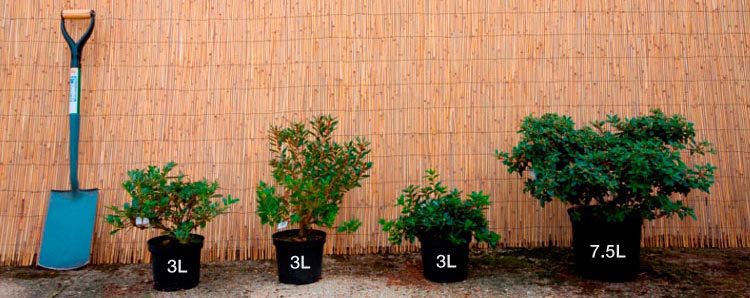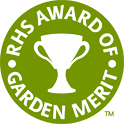Rhododendron Lady Alice Fitzwilliam AGM
Item: TLADY
 Currently Unavailable
Currently Unavailable
April
White & Cream
75-100cm
Scented
No
To -10 °C
Collect in Store
This item is available for collection.
Home Delivery
UK mainland delivery from £8.95
Beautiful strongly scented funnel shaped flowers in trusses of 2 to 3, pink fading to white with yellow markings flowering in April. This is a lovely old hybrid with deeply veined leaves and a distinctive nutmeg flower fragrance. Height 80-100cm in 10 years.
The tender Rhododendrons that we propagate are from the Maddenia sub-section of Rhododendrons. They grow well outdoors in sheltered mild climates such as the West Country, or London courtyard gardens. Alternatively, they make lovely indoor flowering plants for the cool greenhouse or conservatory, before moving outside for the summer. As many of these varieties grow epiphytically in boughs of trees, they need a coarse growing medium and excellent drainage. If grown in a container, they should be allowed to become a little pot-bound and they benefit from being very hard-pruned after flowering.
- Recommended for the greenhouse or conservatory and lovely scented early flower.
- Easy to grow.
- Ideal position: sheltered position in the garden or indoors.
- Habit: compact.
- Group: Rhododendron hybrid.
- Parentage: edgeworthii X formosum.
- Hybridization date: pre 1900 (1881).
- Bred by: Fisher, Son & Sibray of Handsworth Nurseries, Sheffield. Origin: British.
- Ideal soil: pH 4.5 to 6.
- RHS Hardiness Rating: H4.
- Awards: RHS Award of Garden Merit.
Good to know
Tender
Tender (maddenia) Rhododendrons are suitable for the cold greenhouse and mild areas such as Cornwall where they can be grown outdoors. Elsewhere in sheltered gardens they are worth trying against a South facing wall if temperatures are unlikely to go below -5°C. They give a magnificent display in spring, and the pinks and whites often have gorgeous scent to fill a conservatory. Many of these rhododendrons are epiphytic, meaning that they naturally grow in the boughs of forest trees and rock crevasses. Hence they often grow and flower better when their roots are constrained in a relatively small pot, and they need a very free draining (orchid type) compost, with just a teaspoon of slow release fertilizer.
When grown in a conservatory, these plants grow vigorously, so prune hard straight after flowering to encourage bushiness, leaving only about 10cm of the previous year's growth. They much prefer to be grown outside during summer months where there is fresh air and rainfall, so try to move out after frosts in May, and bring back indoors in October or November. Heating is usually not needed in the UK, and plants can be easily scorched if placed too close to radiators or heaters, or where there is lack of air movement within a conservatory.
Please note: Watch out for sooty mould on plants grown under protection (see advice centre for further information).
The Basics
Ideal soil
Acidic soil, good organic content, pH 4.5-6.0. Inkarho range of rhododendrons will tolerate soils up to pH7.5
Sun or Shade
Light dappled shade is best for most varieties.
Shelter
Refer to hardiness rating. Give young plants protection.
Site Selection
Avoid close to trees, roots, invasive weeds, walls, hot patios, dry banks and waterlogged soils. Do not use weed matting or stone mulch.
Plant spacing
Use the height shown in 10 years as a guide to the distance between each plant. Allow room for plant to fill out. If planting closer for instant impact, be prepared to move plants after a few years.
Compost
- 3 litre pot, dig in 10-20 litres of ericaceous compost.
- 7.5 litre pot, dig in 20-30 litres of ericaceous compost.
- 70-80cm specimen, dig in 60 litres of ericaceous compost.
- 100-120cm specimen, dig in 120 litres of ericaceous compost.
Planting depth
Plant high in the ground, with the top of the rootball visible.
Feeding
Slow-release ericaceous feed recommended in March and straight after flowering.
Mulch
Recommended every few years.
Water
The key ingredient! Keep moist all season, especially the critical time at end of June for flower bud initiation. Tap water is better than no water. Heavy dose at least once per week in dry weather.
Drainage
Ensure good drainage in winter, especially with yellow flowering varieties. Avoid waterlogged sites.
Pruning
Rhododendrons and Camellias: Not normally required. Tidy wayward shoots after flowering.
Evergreen azaleas and Bloombux can be clipped into a low hedge.
Magnolias and Acers: Formative pruning when young to shape into a tree or bush.
Deadheading
Remove old flower-heads, particularly on young or weak plants.
For further advice see here
Size Guide

Delivery & Returns
Our website calculates the delivery charge according to weight and delivery location throughout the UK. To see these charges, please enter your postcode at the checkout, and you will see the charge vary as you add more items to your wheelbarrow.
 Millais Nurseries
Millais Nurseries





